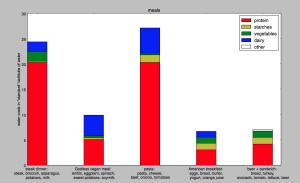-8:30: my “eat breakfast, you degenerate” alarm goes off. my phone is synced with the cloud and collects metadata about my usage. I grudgingly wake up and check my email while lying in bed (server access data; gmail usage; reply/deletion actions are recorded, and whoever I reply to knows I wake up around 8:30).
-8:50: i use the bathroom; i assume East Campus’ water usage is monitored in aggregate, so mine becomes part of the total. to avoid waking my roommate, i do my hair and makeup in the communal bathroom instead of our room. my aim is to avoid creating any stimulus that will wake her, whether that be light or sound. does that count as data?
-9:00: breakfast. i recycle the empty soymilk container and the box of cereal i just finished; to an enterprising investigator, trash could be considered a form of aggregate data about my hall’s eating habits.
-9:20: i head to class with my friend. we leave footprints in the snow; my shoe size, footprint, and gait pattern are probably individually identifiable. my phone has GPS enabled because my friends and i installed an app that pings my location to them, but i have (as i often do) left my phone in my bed.
-10:00: i ask a question in class. the girl next to me writes down the professor’s answer in her color-coded latex-ed notes. i am also knitting a hat in class; its length is a linear function of time spent not completely engaged in class. one of my friends sitting near me sends me an email about my hat.
-11:00: i arrive at 6.046 lecture, which is being taped. i spend the lecture knitting. i don’t think i’m in the camera’s field of vision, though.
-12:30: i go to the course 6 lounge, using my ID to access, and make coffee.
-1:00: Japanese class. i take a quiz; my score will presumably live in a spreadsheet somewhere and be used to calculate my grade.
-2:00: finally, a break. i use my MIT ID to access my dorm, check my email, reblog a few posts on tumblr, and access facebook. i don’t like anything, but i do click several links. i leave my dorm and use my debit card to buy food at the food truck by MIT Medical.
-3:00: i head to CMS.631. I check out links on my computer (internet browsing data), contribute points and ideas to the posters on the walls, which are going to be used to shape the course of the class.
-4:30: i go home (ID for access again). my roommate is still asleep. our electrical usage, which i have heard is tracked by room, is negligible except for the heater and various chargers for the day.
-5:00: i browse the internet and eat random food that belongs to me and i found in the freezer. it has been a fixture in the freezer for a long time; the next person looking for food might be perplexed that a landmark they’ve come to rely on is gone. there’s probably a ton of browsing data, tumblr reblogging, and email replies/deletions/reads.
-6:00: i decide it’s a great idea to work out instead of taking a nap. i used to use an app that tracked the miles i ran and the speed at which i ran; since it encouraged me to run as far as i could (and therefore get overuse injuries) i bring my phone with me only to listen to music. GPS is enabled, so my friends, if they wanted to know, are aware of my location.
-6:50: i have a 7 pm class. i grab clothes from the shelves. my roommate, if she was nosy (she’s super awesome and probably wouldn’t pry into my life that much), could deduce that i’ve worked out (gym clothes in my laundry bag and the shelves where my clothes live are a mess because i couldn’t find pants)
-7:00: i attempt to get into the Media Lab. i don’t have card access. someone somewhere knows i tapped my card unsuccessfully about 3 times. someone with access lets me in.
-7:45: my hat is longer. i’ve clicked several links on the class subreddit.
-8:30: we attempt to eat dinner with the housemaster. card access to the west parallel of east campus. all the food is gone. he is perplexed to see us.
-8:50: my friend invites me to dinner at maseeh. i tap my ID again.
-10:00: i begin to attempt homework. many, many wikipedia pageviews, mostly linear classification and the perceptron algorithm. somehow i also end up reading up on the use of singular “they,” gender in news reporting, and ethics….meanwhile i’m listening to music on either pandora or youtube, who are definitely collecting data about my listening patterns and preferences, which are way more mainstream than i’ll ever admit to. my youtube homepage is deeply embarrassing.
-12:00: i write out Japanese vocabulary on the chalkboard in the hallway. people walking by after i go to sleep will know i was studying the meaning of “to see, honorific” and “space alien,” probably for a quiz tomorrow, because i talk a lot about how terrible i am at studying vocabulary.
-1:30: more tumblr; likes and reblogs. the books scattered on my desk explain, roughly, what i’ve been working on tonight. i write myself notes on my hand about the things i need to get done tomorrow. i set alarms to wake tomorrow, reply to some last emails, and fall asleep. the fact that the light is off in the room and the person-shaped lump in the corner inform my roommate that i’m trying to sleep, so she’s super stealthy when she comes in. those are the best kinds of data-driven decisions.


